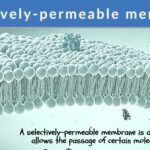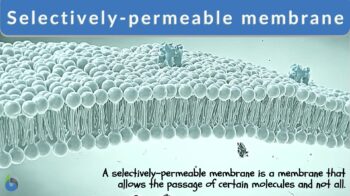
Selectively-permeable membrane
n., plural: selectively-permeable membranes
[sɪˈlektɪvlɪ ˈpɜːmɪəbəl ˈmɛm.bɹeɪn]
Definition: a membrane that is permeable to only certain molecules and not to all molecules
Table of Contents
Selectively Permeable Membrane Definition
We can define selectively permeable membranes as those that are selectively permeable. They allow the entry of only a few substances and molecules. This is done to maintain the internal environment of the cell to a constant or nearly constant level.
A selectively-permeable membrane is a membrane that allows only some substances and molecules to pass into or leave the cell. An example of a selectively-permeable membrane is the cell membrane. It allows the passage of only certain types of molecules through diffusion and occasionally by facilitated diffusion. Synonyms: semipermeable membrane; partially-permeable membrane; differentially-permeable membrane
All cells are surrounded by a selectively-permeable membrane. This membrane not only surrounds the cellular organelles but also acts as a barrier between the internal and the external environment. A cell membrane that is selectively permeable acts as a boundary or fence of the cell. It allows the molecules to pass through active or passive transport.
- Active Transport
- Passive Transport
- Free Diffusion
- Facilitated Diffusion
Active transport
It is the in and out movement of molecules or ions from the cell membrane by the expenditure of energy. This energy comes from the hydrolysis of the phosphate group of ATP.
For example: In some cells, there is a surplus amount of sodium ion outside the cell and a large amount of potassium ion is present inside the cell. By using the transmembrane enzyme Na+/K+ ATPase, the movement of sodium and potassium ions is catalyzed outside and inside the cell.
Passive Transport
It is the in and out movement of molecules or ions from the cell membrane without the expenditure of any energy.
Free Diffusion
Free diffusion involves the movement of uncharged molecules, for example, ethanol and carbon dioxide. In this movement, there is no involvement of any other molecules.
Facilitated Diffusion
It needs the presence of any other molecule like protein. The protein acts as a carrier and thus helps the substrate in crossing the cell membrane. For example, the Transport of oxygen is accomplished after its binding with hemoglobin.
Selectively-permeable Membrane Examples
A selectively-permeable membrane helps in maintaining the balance among the several organelles inside the cell. Each organelle is a considered small compartment that is specialized to perform specific tasks. For accomplishing the task effectively, they require an optimal concentration of ions, molecules, and proteins. Following are the different biological examples that explain the importance of selectively permeable membranes in order to function more effectively.
1. Mitochondria are one of the most essential organelles of the cell. A mitochondrion is considered the powerhouse of the cell. It is responsible for cellular respiration and the process is the aid of certain proteins. A selectively permeable membrane performs this task. It brings in proteins without disturbing the internal chemistry and metabolic rate of inter and extracellular environments.
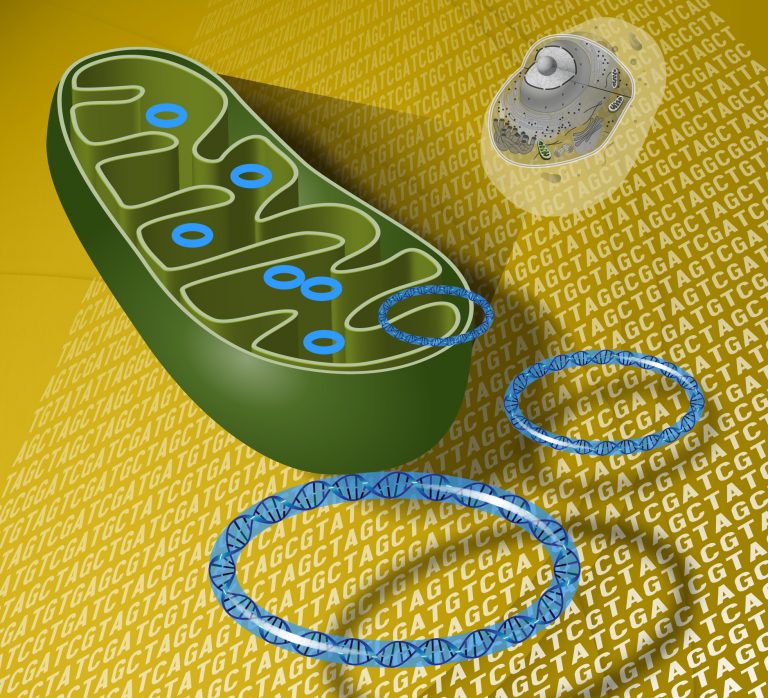
2. A neuron comes to an excited state while transmitting the electrochemical signal. Before passing the next signal it should be recovered and return to its resting potential. This alternate excitation and relaxation of the neuron are maintained by a selectively permeable membrane by the selective discharge of ions.
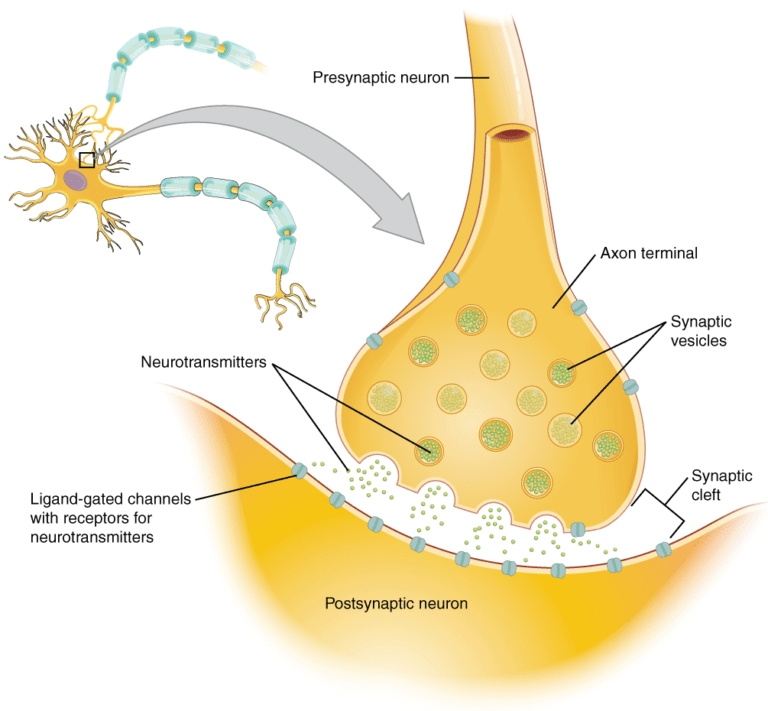
3. The alternate excitation and relaxation also happened in cardiac muscles and heartbeat. A selectively permeable membrane is responsible for maintaining equilibrium among the inter and extracellular environment for keeping the heartbeat normal.
Structure of Selectively-permeable Membrane
It is not easy to visualize the cell membrane through a light microscope. Due to this, the hypothesis about the existence of selectively permeable membrane (cell membrane) came in the late 19th century, almost 200 years after the cell had been discovered. At different times, different models had been suggested to explain what is a selectively permeable membrane. The model which was widely believed to be accurate is known as the “Fluid Mosaic Model”.
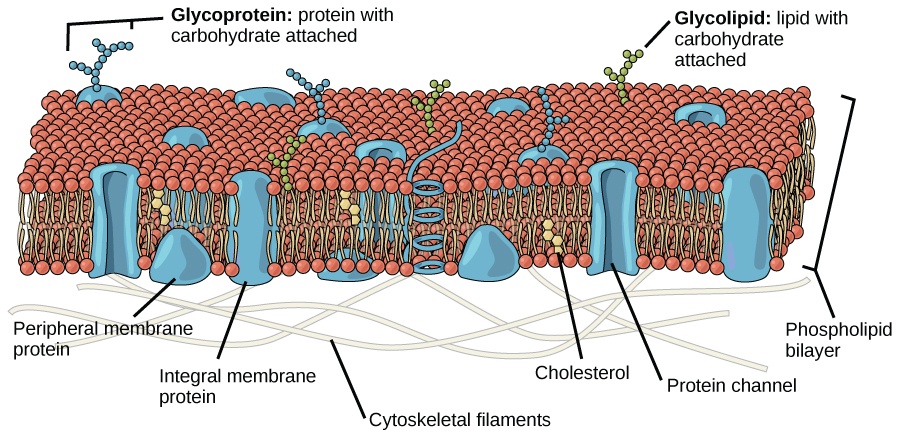
Fluid mosaic model
The selectively permeable cell membrane was identified in the 1890s but its chemical composition was explained in 1915. The structure of the cell membrane makes it flexible which makes it an ideal boundary for growing cells. Lipids and proteins are identified as the main components in the membrane.
James Danielli and Hugh Davson in 1935, proposed the structure of the membrane. This was the first structure that was accepted widely. It was explained as a “railroad track” due to its appearance in early electron micrographs. Danielli and Davson said that the structure of a selectively permeable membrane resembles a sandwich. They said proteins are like bread and lipids are in the form of filling.
With the passage of time and advancement in transmission electron microscopy (TEM), a more defined structure was proposed in the 1950s. According to this, the structure consists of a double-layer despite being single. S.J. Singer and Garth L. Nicolson in 1972 proposed a new and better model for explaining the structure of the selectively permeable membrane.
Although the fluid mosaic model evolved still it explains the structure of selectively permeable membrane in the best way. The fluid mosaic model said that the plasma membranes are selectively permeable; this means that the structure of a selectively permeable membrane is a mosaic of components that includes proteins, phospholipids, carbohydrates, and cholesterol. Cholesterol or protein molecules are either embedded or present on the entire lipid bilayer.
There is variation in the structure of a selectively permeable membrane and other membranes. It has multiple nuclear pore complexes. The multiprotein complexes allow the entry of water but act as a barrier for other macromolecules. This characteristic makes a cell membrane selectively permeable.
The membrane ranges from 5-10 nm in thickness. We compare it with human red blood cells, for better understanding, which is visible by light microscope. The human red blood cell is 8 µm wide, almost 1000 times wider than the selectively permeable membrane.
3 Structural components of the plasma membrane
The main components of selectively permeable are proteins, lipids (cholesterol and phospholipids), and carbohydrates. Carbohydrates are attached to some of the proteins and lipids.
1. Proteins: The proteins form gates, channels, or pores that provide selective permeability to the membrane. It gives signals to the molecules according to the requirement of the cell. The membrane proteins are of two types.
- Extrinsic proteins: It is loosely attached by calcium bridges or ionic bonds to the electrically charged phosphoryl surface of the bilayer. Extrinsic proteins also get attached to intrinsic proteins.
- Intrinsic proteins: As the name indicates, intrinsic proteins are also embedded in the phospholipid bilayer. A large proportion of intrinsic protein is found in those membranes which are highly involved in metabolic reactions.
The proportion of proteins, carbohydrates, and lipids in the selectively permeable membrane varies according to the type of cell. In a human cell, the concentration of protein is 50%, lipids are 40% and carbohydrates are about 10%. However, the proportion of lipids and protein varies in different membranes.
For example, The outgrowth of axons which is myelin comprises 76% lipids and only 18% proteins. The inner membrane of mitochondria consists of 24% lipids and 76% proteins.
2. Lipids: the lipid components include phospholipids and cholesterol.
A phospholipid mainly consists of three components:
- Glycerol
- Two fatty acids
- Phosphate linked head group
Each phospholipid is amphipathic which means it has a hydrophilic head and two hydrophobic tails. The hydrophilic head faces outside and the hydrophobic tail faces inside.
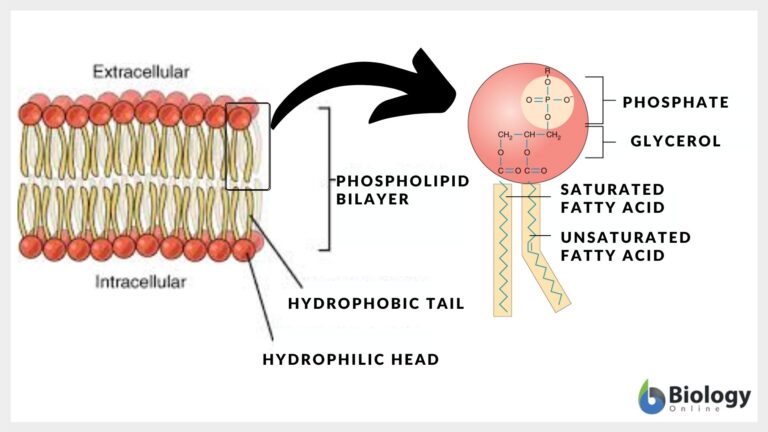
Another lipid component is cholesterol. It consists of four fused carbon rings. It is situated alongside phospholipid.
3. Carbohydrates: On the exterior surface of a selectively permeable membrane, carbohydrates are found. They are either attached to the proteins or lipids and form glycoproteins and glycolipids respectively.
Functions of Selectively-permeable Membrane
1. The selectively permeable membrane also refers to the cell membrane, providing anchoring to the cytoskeleton. The cytoskeleton provides shape to the cell and in attaching the extracellular matrix and other cells to hold them together and from tissues.
2. The selectively-permeable cell membrane protects the cell. It maintains the balance in the internal environment of the cell by transporting the toxic substances outside the cell and bringing the nutrients inside the cell.
3. Selectively-permeable membranes help in maintaining the integrity of the intracellular environment as compared to the extracellular environment.
4. It forms a barrier between the cellular organelles and the outside environment.
5. In eukaryotic cells, a selectively-permeable membrane is essential for the transport of molecules across the nuclear membrane. In transcription, not only the specific nucleotides, proteins, and nucleic acids must be transported into the nucleus efficiently and specifically but also the products must be exported on time.
6. The environment of the nucleus is distinguished from the cytoplasm. Selectively-permeable membrane functions effectively in maintaining equilibrium among these so that the overall cellular function is achieved more efficiently.
7. A selectively-permeable membrane facilitates communication and signaling between the cells.
Try to answer the quiz below to check what you have learned so far about selectively-permeable membrane.
References
- Academy, K. (2021). The cell membrane review. Retrieved 18 Oct, 2021, from https://www.khanacademy.org/science/ap-biology/cell-structure-and-function/plasma-membranes/a/hs-the-cell-membrane-review
- Arrington, D. (2021). Selectively Permeable Membranes: Definition & Examples. Retrieved 18 Oct, 2021, from https://study.com/academy/lesson/selectively-permeable-membranes-definition-examples-quiz.html
- Gahl, W. (2021). Plasma Membrane (Cell Membrane). Retrieved 18 Oct, 2021, from https://www.genome.gov/genetics-glossary/Plasma-Membrane
- Maker, L. w. (2021). Structure of the Cell Membrane. Retrieved 18 Oct, 2021, from https://courses.lumenlearning.com/wm-biology1/chapter/reading-structure-of-the-cell-membrane/
- Rogers, K. (2021). Cell membrane. Retrieved 18 Oct, 2021, from https://www.britannica.com/science/cell-membrane
©BiologyOnline.com. Content provided and moderated by Biology Online Editors.


